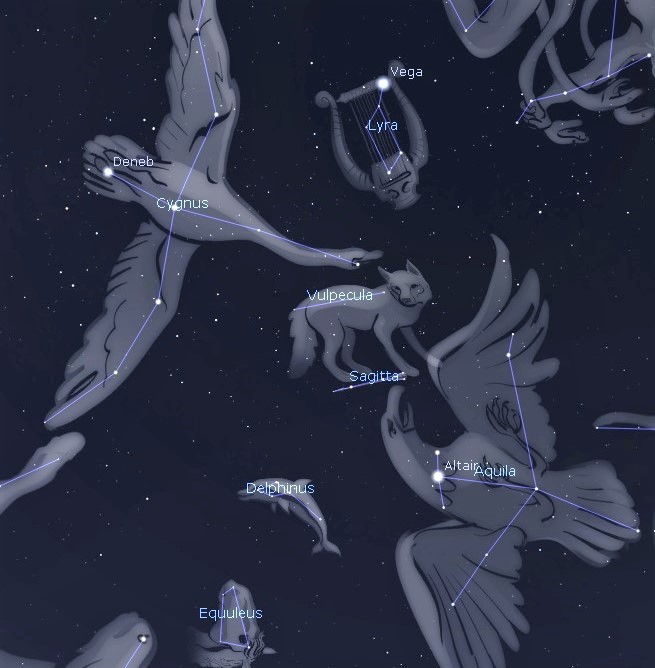This Week’s Sky at a Glance, 2020 July 25 – August 1
~by Curt Nason
They say it is the little things that count, and if you are counting constellations there are four little ones lined up in the southeast toward late evening. Start your search with the Summer Triangle, which is composed of the brightest star in each of three constellations: Vega in Lyra the Lyre, Deneb in Cygnus the Swan, and Altair in Aquila the Eagle. Sagitta the Arrow is a distinct shape between Altair and Albireo, which is at the head of Cygnus. The arrow, poisoned with the blood of the Hydra, is one of those shot by Hercules to kill the Stymphalian birds as his sixth Labour.
Between Sagitta and Albireo is obscure Vulpecula the Fox, which at one time was two constellations called the Little Fox and the Goose. Vulpecula is known best for having the binocular object M27, the Dumbbell Nebula, within its borders. Below Sagitta is the eye-catching Delphinus the Dolphin, seen leaping out of the watery constellations that hug the horizon below. The dolphin was given its place of honour in the sky by Poseidon for convincing beautiful Amphitrite to be his wife. Below Delphinus and just off the snout of Pegasus the Flying Horse is Equuleus the Little Horse, the second smallest of the 88 constellations. Perhaps representing the foal Celeris, an offspring or brother of Pegasus, it was one of the 48 constellations included in Claudius Ptolemy’s second-century map of the sky.
This Week in the Solar System
Saturday’s sunrise in Moncton is at 5:53 am and sunset will occur at 8:56 pm, giving 15 hours, 3 minutes of daylight (6:01 am and 8:59 pm in Saint John). Next Saturday the Sun will rise at 6:01 am and set at 8:46 pm, giving 14 hours, 45 minutes of daylight (6:09 am and 8:50 pm in Saint John).
The Moon is at first quarter on Tuesday and it spends the week sneaking up on Jupiter. Both Jupiter and Saturn are in the southeastern sky during evening twilight. Telescope users might see Jupiter’s Red Spot around 10 pm Wednesday and 11:30 pm on Friday. Just past opposition, Saturn’s rings appear brighter than usual because their icy components reflect sunlight directly toward us, a phenomenon called the Seeliger Effect. Mars has brightened to magnitude -1, and over the next couple of months it will rival Jupiter’s brilliance in the evening sky. Mercury is also brightening, making this a great week to spot it as it rises an hour and a half before the Sun. Venus, the brightest planet, dominates the morning sky. Having recently passed its closest point to the earth, comet C/2020 F3 NEOWISE is zipping westward by about three degrees per day and should remain a stunning sight in binoculars.
With astronomy meetings and outreach activities on hold, you can watch the local Sunday Night Astronomy Show at 8 pm and view archived shows.
Questions? Contact Curt Nason.

